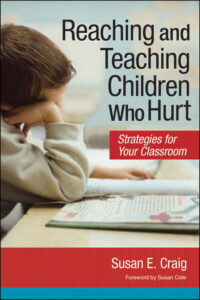Trauma-Sensitive Tips for Helping Students Sustain Attention
May 16, 2023
 *Today’s blog post has been adapted from Susan Craig’s popular book, Reaching and Teaching Children Who Hurt.
*Today’s blog post has been adapted from Susan Craig’s popular book, Reaching and Teaching Children Who Hurt.
Paying attention—in a classroom or in any other setting—always involves selecting from a variety of competing options. Children attend to what they have been taught to see. Their brains’ neural networks look for patterns established by past experience. Students who have learned to look to adults as sources of information and positive support are primed to direct their attention to what teachers say. They’re well prepared to pay attention to the content of your instruction.
But when children have had past experiences with unpredictable, capricious adults, they are always on the lookout for hints of displeasure or emotional volatility. Their attention is directed toward facial expressions and gestures that may signal danger. Because these students are primed to direct their attention toward what teachers do, they often miss the content of what is being said. As they focus their attention on assessing the potential danger of the interaction, they’re distracted from the task at hand: acquiring new skills and information. And when these students are accused of not paying attention, they are left frustrated and feeling powerless.
So what can you do as a teacher to support students who have experienced trauma from adults? How can you create feelings of safety and help students direct and sustain their attention? Here are some tips to try:
- Design lessons that include movement and interactions with peers.
- Encourage students to participate in intense physical activities such as running, climbing, dancing, and so forth. Exercise helps “kick start” the attending systems of people who require more stimulation to be ready to learn.
- Take time before introducing content to make an emotional connection with students. Remind them of the things that are going well. Then tell them they need to listen very closely to the content of what you are about to say. Ask several children to retell the directions to make sure everyone understands them.
- Always pair oral directions with written ones. Never assume that students can act on what you have told them to do.
- Use pictures of you and your students doing cooperative, positive things together as a reminder of the positive nature of your relationship with them. Refer to the photos often, recalling with your students things you have accomplished or enjoyed together. (Ensure that parents have signed and returned permission to photograph slips at the beginning of the school year.)
- Incorporate stress management techniques into classroom activities and routines. These techniques might include deep breathing, stretching exercises, yoga movements, affirmations, and calming mantras.
- Try visualization exercises to help students stay calm enough to focus. Keep a collection of pictures that students find soothing in a special folder. Hang up a picture and encourage children to look at it often and to try to visualize it in their minds. When you see a student getting stressed, say, “Let’s close our eyes and go to the beach for a minute.”
- Provide children with precise feedback on what they can do to improve their performance. Avoid using phrases such as “good work” that do not specify what parts of the performance make it good.
- Give students opportunities to submit several drafts of papers or projects so that editing or making changes is seen as part of the process rather than an evaluation.
- Monitor the pace of the classroom day to ensure that children have adequate time to make transitions. Avoid rushing them or placing too many demands on them at one time. This can lead to neurological “flooding” and a downshifting to survival mode.
- Remind students several times a day that they are safe in school. Work with them to develop safety plans that include knowing what to do in an emergency and how to respond to peers who may be speaking or acting in a way that is threatening or harmful to their emotional safety.
- Follow through on things that you tell children you will do. Do not make promises you cannot keep.
- Appoint students to a classroom safety committee that is responsible for ensuring that safety rules—such as no running, no hitting, and no bullying—are enforced. Have members of this committee bring up safety concerns at classroom meetings so that all students can work together to solve them.
Paying attention is a complex process that’s essential to both learning and behavior. Use these trauma-sensitive tips to help students stay calm, focused, and ready to engage with your instruction. And for a practical guide to making a positive difference for students who have experienced trauma, pick up the book behind today’s post.
 Reaching and Teaching Children Who Hurt
Reaching and Teaching Children Who Hurt
Strategies for Your Classroom
By Susan E. Craig, Ph.D.
Discover how to create supportive classrooms that meet the complex learning needs of children who hurt—and help the most vulnerable students build resilience and hope. Get simple strategies for helping students with problem solving, stress management, peer relationships, goal setting, critical thinking, self-regulation, and more!




Write a Comment
Your email address will not be published. Required fields are marked *
Post a Comment